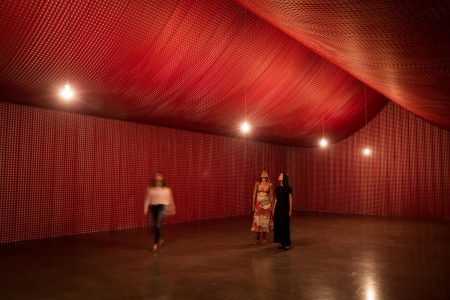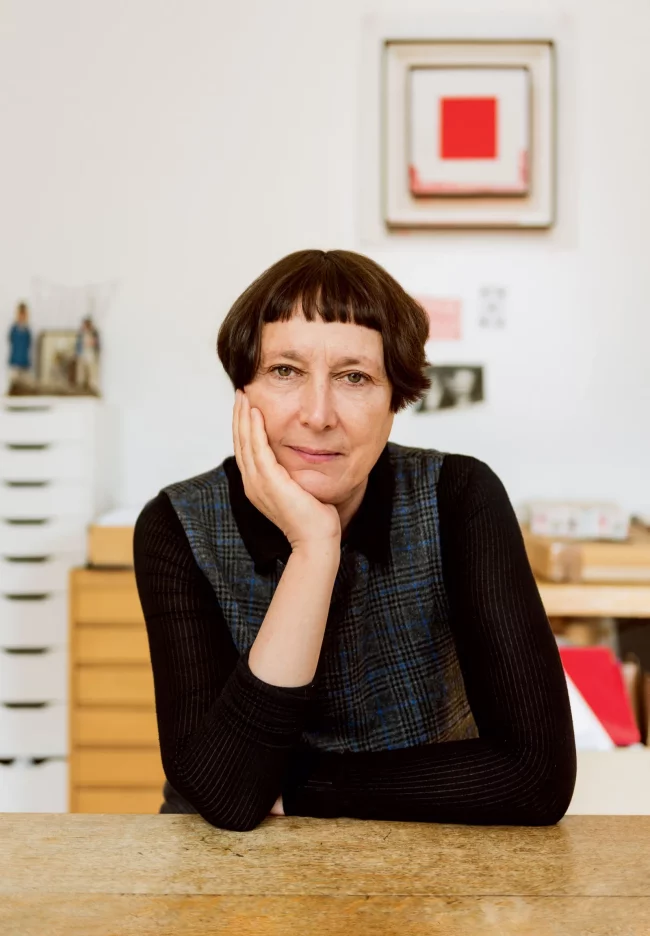Visited Friday 8 November 2019
Reviewed by Rosalind Gustafson

One of the first things one might notice about the Cornelia Parker exhibition is the diversity of materials used. I do not just mean this in the sense of there being documentaries, videos, books to peruse, and an audio guide in addition to the artworks and art installations. But the art itself is very diverse, and one might be surprised at the range of materials Parker uses: chalk from the White Cliffs of Dover, guns in the earliest stage of production, a doll cut by the guillotine that beheaded Marie Antoinette, residue from cutting the original grooves in records, rattlesnake venom, anti-venom, earth excavated from under the Leaning Tower of Pisa that had been there for a thousand years, a spent lightbulb exposed by a live match, and so on and so forth. No acrylics here, everything is something that anyone might find out in the world, and this leaves one wondering just what can be transformed into art if given the right thought. As Parker says, her work “is about the potential of materials—even when it looks like they’ve lost all possibilities”. For someone who is unacquainted with her work, the range of materials lends the exhibition a great deal of fascination, and it is more than guaranteed of holding a person’s attention all the way through. Certainly, one can expect a surprise around practically every corner, and this is both to the exhibition and Parker’s credit; I’m not very artistic myself, but I know I like an artist who can think outside the box.
The themes that run through the exhibition are about as diverse as the materials used, and this is, I feel, one of the exhibition’s main strengths. Principal themes include opposing states and the transformation of the mundane into something more, through various unusual means, and these run through the whole of the exhibition. Prime examples include Thirty Pieces of Silver and Cold Dark Matter, steamrollered silverware and the debris of a shed blown up by the British Army, reconstructed into a moment mid-explosion. Others include Passive, Aggressive; Love, Hate; and War, Peace, which include the various definitions of the words embroidered in two different colours, one running from left to right, the other from right to left. Bullet Drawing is yet another, involving the lead from a bullet being drawn into a wire, and thus turned from something to be feared to something that is quite benign, if inert. This ability to meld opposing states together while showing the contrast between them and to turn the mundane into legitimate artistic materials is an impressive one, and it makes a good choice for the primary theme of the exhibition.
Still, there are other themes, and these are equally strong and important, perhaps even more so when considered in the current political situation. In the discussion of the Magna Carta (An Embroidery), for instance, emphasis is placed on the fact that the embroiderers came from many walks of life, from members of the Embroiderers’ Guild to prisoners to lawyers to MPs to even whistle-blowers Assange and Snowden. In so doing, Parker follows the theme for which the Magna Carta has become an important symbol, that everybody is or should be equal under the law, and she also represents the democracy of Wikipedia, in how everybody is allowed to contribute to everything. In a time when many feel the law favours some while leaving others behind and where particular groups, including prisoners and felons, are often disenfranchised, this is an important message to remember, that everyone has a valuable contribution to make.

Similarly, the 2007 discussion with Noam Chomsky about climate change and the need to act is as relevant today as it was then, and it offers a sobering reminder that though it has been twelve years, next to nothing has been done to combat climate change. Finally, the video artwork Left, Right, and Centre, which shows a variety of left-wing and right-wing newspapers read in the House of Commons being scattered into one group by a drone, demonstrating perhaps the current political quagmire in the United Kingdom and the general population’s disgust with the politicians. These are all themes that are very relevant to our modern era, even if we do not live in the United Kingdom, and they can easily lead a viewer to think about how things can change, if things can change, and what needs to be done. At the same time, the exhibition is given not just aesthetic attractiveness, but relevance, and this is what will ensure it is not easily forgotten, I feel.
Overall, I can find few faults with the exhibition, but one concern I did have was with the number and length of the videos presented. There is a proliferation of videos, including the Imagine… Danger! documentary, an interview with curator Rachel Kent, a discussion with Noam Chomsky, an explanation of the process behind the making of the Magna Carta (An Embroidery), and at least five video artworks including Made in Bethlehem, Thatcher’s Finger, War Machine, Election Abstract, and Left, Right, and Centre. The Imagine Danger documentary alone is over an hour long, the discussion with Noam Chomsky 45 minutes, and most of the others over seven minutes each. Between these videos and the audio guide in which Parker discussed some of her more notable works, I felt I spent more time listening and watching things than taking in the artwork. I additionally feel that Thatcher’s Finger and Made in Bethlehem were presented with no explanation or context, and I cannot work out the reasons for their inclusion in the exhibition or their meanings, especially with Thatcher’s Finger, which is a shadow-play revolving around a sculpture of the former Prime Minister and its pointing finger. After a certain point, the number of videos got rather overwhelming and distracting, and I suspect they can only truly be enjoyed by someone who has plenty of time on their hands.
In short, this is an excellent exhibition, one that is relevant to current times, aesthetically pleasing, and guaranteed to fascinate and surprise all at the same time. I would definitely recommend a visit for anyone who’s interested, though perhaps make sure you have plenty of time on your hands to take in the videos. You don’t want to miss the full experience of an exhibition like this.
What: Cornelia Parker
When: Friday 8 November 2019–Sunday 16 February 2020
Where: Museum of Contemporary Art, The Rocks, Sydney
Price: $24 for adults, $19 concession
Exhibition details here: Cornelia Parker
